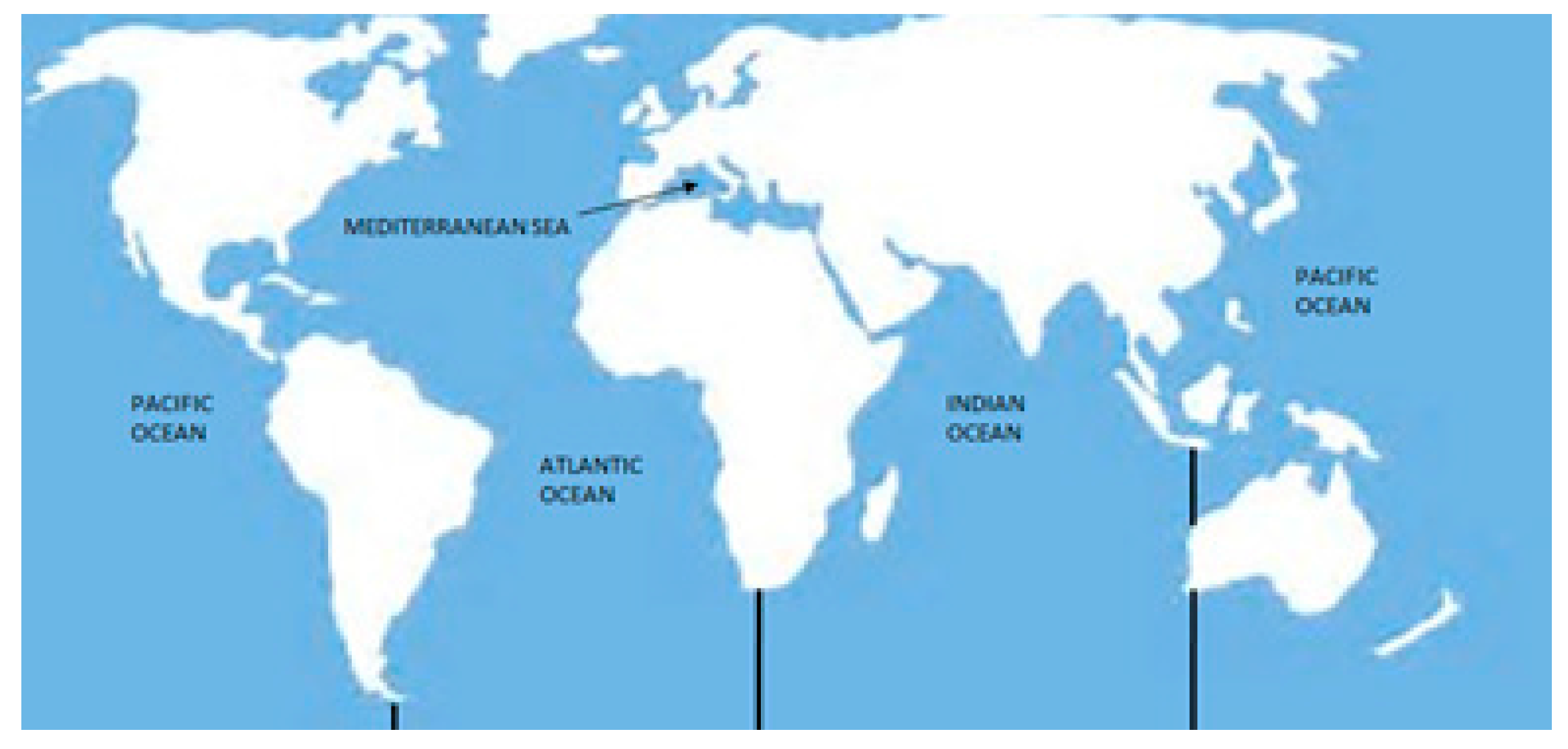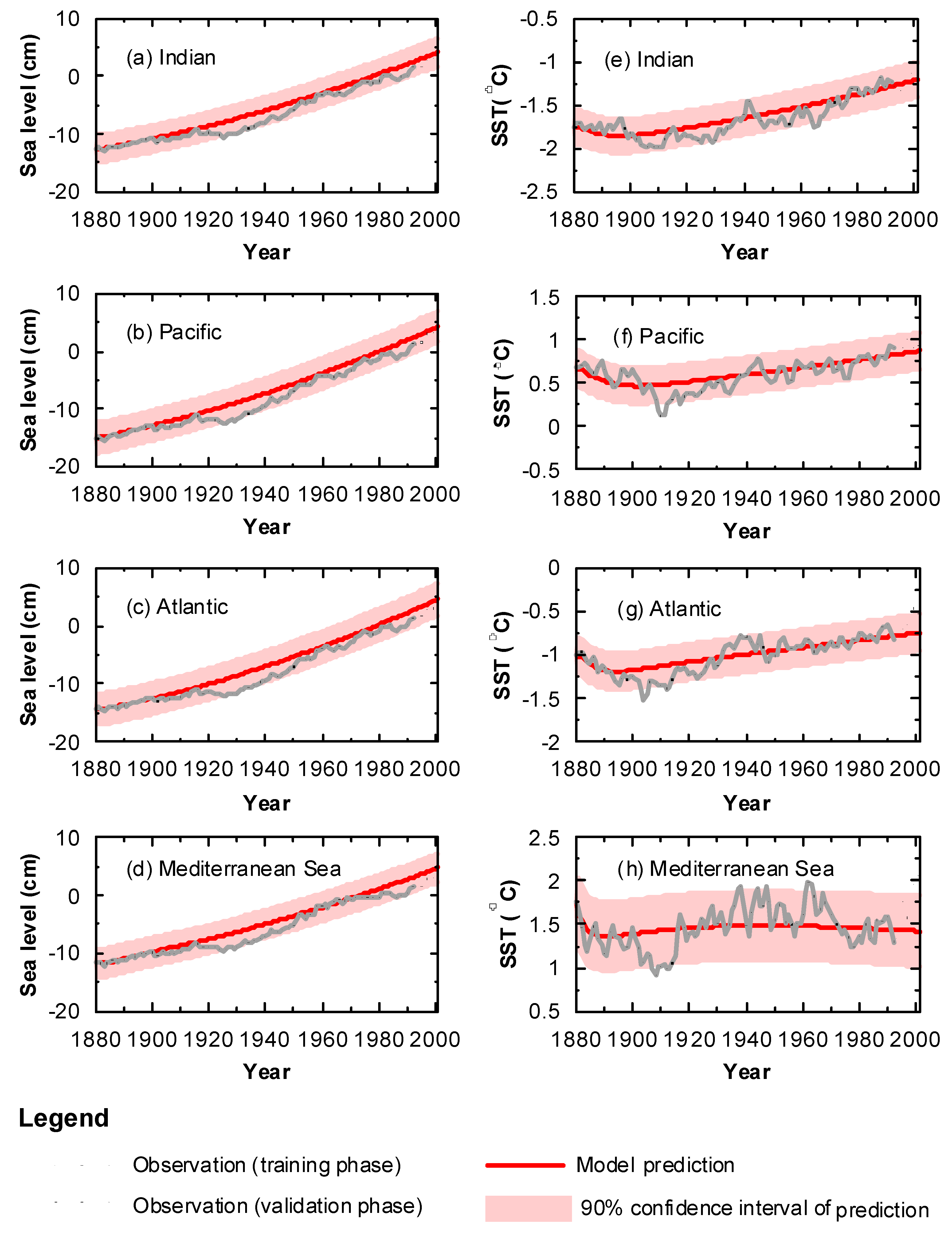Spatial Variation of Sea Level Rise at Atlantic and Mediterranean Coastline of Europe
Abstract
:1. Introduction
2. S-DSM Model for Four Ocean Regions
3. Model Calibration
4. Numerical Results and Discussion
5. Conclusions
Acknowledgments
Author Contributions
Conflicts of Interest
References
- Brown, S.; Nicholls, R.J.; Lowe, J.A.; Hinkel, J. Spatial variations of sea-level rise and impacts: An application of DIVA. Clim. Chang. 2016, 134, 403–416. [Google Scholar] [CrossRef]
- Chang, B.; Guan, J.; Aral, M.M. Modeling spatial variations of sea level rise and corresponding inundation impacts: A case study for Florida, USA. J. Water Qual. Expo. Health 2013, 6, 39–51. [Google Scholar] [CrossRef]
- Meehl, G.A.; Stocker, T.F.; Friedlingstein, W.D.; Collins, P.; Gaye, A.T.; Gregory, J.M.; Kitoh, A.; Knutti, R.; Murphy, J.M.; Noda, A.; et al. Projections of global average sea level change for the 21st century. In Climate Change 2007: The Physical Science Basis. Contribution of Working Group I to the Fourth Assessment Report of the Intergovernmental Panel on Climate Change; Solomon, S., Qin, D., Manning, M., Chen, Z., Marquis, M., Averyt, K.B., Tignor, M., Miller, H.L., Eds.; Cambridge University Press: Cambridge, UK; New York, NY, USA, 2007. [Google Scholar]
- Neil, J.W.; Ivan, D.H.; John, A.C.; Terry, K.; Christopher, S.W.; Tim, R.P.; Phil, J.W.; Reed, J.B.; Kathleen, L.M.; Zai-Jin, Y.; et al. Australian sea levels—Trends, regional variability and influencing factors. Earth Sci. Rev. 2014, 136, 155–174. [Google Scholar]
- Nicholls, R.J.; Wong, P.P.; Burkett, V.; Codignotto, J.; Hay, J.; McLean, R.; Ragoonaden, S.; Woodroffe, C.D.; Abuodha, P.A.O.; Arblaster, J. Coastal systems and low-lying areas. In Climate Change 2007: Impacts, Adaptation and Vulnerability. Contribution of Working Group II to the Fourth Assessment Report of the Intergovernmental Panel on Climate Change; Parry, M.L., Canziani, O.F., Palutikof, J.P., van der Linden, P., Hanson, C.E., Eds.; Cambridge University Press: Cambridge, UK; New York, NY, USA, 2007; pp. 316–357. [Google Scholar]
- Asbury, H.S.; Kara, S.D.; Peter, A.H. Hotspot of accelerated sea-level rise on the Atlantic coast of North America. Nat. Clim. Chang. Lett. 2012, 2, 884–888. [Google Scholar] [CrossRef]
- Intergovernmental Panel on Climate Change. Summary for Policymakers. Available online: http://www.ipcc.ch/report/ar5/wg1/ (accessed on 26 January 2017).
- Rosenzweig, C.; Solecki, W. New York City Panel on Climate Change, Climate Risk Information: Observations, Climate Change Projections, and Maps; Prepared for use by the City of New York Special Initiative on Rebuilding and Resiliancy; Rosenzweig, C., Solecki, W., Eds.; New York City Panel on Climate Change (NPCC2): New York, NY, USA, 2013. [Google Scholar]
- Cazenavea, A.; Bonnefond, P.; Merciera, F.; Dominha, K.; Toumazoua, V. Sea level variations in the Mediterranean Sea and Black Sea from satellite altimetry and tide gauges. Glob. Planet. Chang. 2002, 34, 59–86. [Google Scholar] [CrossRef]
- Criado-Aldeanueva, F.; Vera, J.D.R.; García-Lafuente, J. Steric and mass-induced Mediterranean Sea level trends from 14 years of altimetry data. Glob. Planet. Chang. 2008, 60, 563–575. [Google Scholar] [CrossRef]
- Le Cozannet, G.; Garcin, M.; Yates, M.; Idier, D.; Meyssignac, B. Approaches to evaluate the recent impacts of sea-level rise on shoreline changes. Earth Sci. Rev. 2014, 138, 47–60. [Google Scholar] [CrossRef]
- Lichter, M.; Felsenstein, D. Asessing the costs of sea-level rise and extreme flooding at the local level: A GIS-based approach. Ocean Coast Manag. 2012, 59, 47–62. [Google Scholar] [CrossRef]
- Marta, M.; Michael, N.T. Comparison of results of AOGCMs in the Mediterranean Sea during the 21st century. J. Geophys. Res. 2008, 113. [Google Scholar] [CrossRef]
- Cabanes, C.; Huck, T.; Verdiere, A. Contribution of wind forcing and surface heating to interannual sea level variations in the Atlantic Ocean. J. Phys. Oceanogr. 2006, 36, 1739–1750. [Google Scholar] [CrossRef]
- Mitrovica, J.X.; Gomez, N.; Clark, P.U. The sea-level fingerprint of west antarctic collapse. Science 2009, 323, 753. [Google Scholar] [CrossRef] [PubMed]
- Pardaens, A.K.; Lowe, J.A.; Brown, S.; Nicholls, R.J.; de Gusmao, D. Sea-level rise and impacts projections under a future scenario with large greenhouse gas emission reductions. Geophys. Res. Lett. 2011, 38, L12604. [Google Scholar] [CrossRef]
- Wunsch, C.; Ponte, R.M.; Heimbach, P. Decadal trends in sea level patterns: 1993–2004. J. Clim. 2007, 20, 5889–5911. [Google Scholar] [CrossRef]
- Etkins, R.; Epstein, E.S. The rise of global mean sea-level as an indication of climate change. Science 1982, 215, 287–289. [Google Scholar] [CrossRef] [PubMed]
- Gornitz, V.L.; Lebedeff, S.; Hansen, J. Global sea-level trend in the past century. Science 1982, 215, 1611–1614. [Google Scholar] [CrossRef] [PubMed]
- Rahmstorf, S. A semi-empirical approach to projecting future sea-level rise. Science 2007, 315, 368–370. [Google Scholar] [CrossRef] [PubMed]
- Holgate, S.; Jevrejeva, S.; Woodworth, P.; Brewer, S. Comment on “A semi-emprical approach to projecting future sea-level rise”. Science 2007, 317, 1866. [Google Scholar]
- Vermeer, M.; Rahmstorf, S. Global sea level linked to global temperature. Proc. Natl. Acad. Sci. USA 2009, 106, 21527–21532. [Google Scholar] [CrossRef] [PubMed]
- Grinsted, A.; Moore, J.C.; Jevrejeva, S. Reconstructing sea level from paleo and projected temperatures 200 to 2100 AD. Clim. Dyn. 2010, 34, 461–472. [Google Scholar] [CrossRef]
- Jevrejeva, S.; Grinsted, A.; Moore, J.C. Anthropogenic forcing dominates sea level rise since 1850. Geophys. Res. Lett. 2009, 36, L20706. [Google Scholar] [CrossRef]
- Jevrejeva, S.; Moore, J.C.; Grinsted, A. How will sea level response to changes in natural and anthropogenic forcings by 2100? Geophys. Res. Lett. 2010, 37, L07703. [Google Scholar]
- Aral, M.M.; Guan, J.; Chang, B. A dynamic system model to predict global sea-level rise and temperature change. J. Hydrol. Eng. 2012, 17, 237–242. [Google Scholar] [CrossRef]
- Guan, J.; Chang, B.; Aral, M.M. A Dynamic Control System Model for Global Temperature Change and Sea level Rise in Response to CO2 Emissions. Clim. Res. 2013, 58, 55–66. [Google Scholar] [CrossRef]
- Aral, M.M. Perspectives and Challenges on Climate Change and Its Effects on Water Quality and Health. Water Qual. Expo. Health 2014, 6, 1–5. [Google Scholar] [CrossRef]
- Aral, M.M.; Guan, J. Global Sea Surface Temperature and Sea Level Rise Estimation with Optimal Historical Time Lag Data. Water 2016, 8. [Google Scholar] [CrossRef]
- Schmith, T.; Johansen, S.; Thejll, P. Statistical analysis of global surface temperature and sea level using cointegration methods. J. Clim. 2012, 25, 7822–7833. [Google Scholar] [CrossRef]
- Wu, Q.; Luu, Q.-H.; Tkalich, P.; Chen, G. An improved empirical dynamic control system model of global mean sea level rise and surface temperature change. Theor. Appl. Climatol. 2017. [Google Scholar] [CrossRef]
- Chang, B.; Guan, J.; Aral, M.M. Scientific Discourse: Climate Change and Sea-Level Rise. J. Hydrol. Eng. ASCE 2015, 20, A4014003-1-14. [Google Scholar] [CrossRef]
- Commonwealth Scientific and Industrial Research Organisation (CSIRO) Sea Level Data. 2011. Available online: http://www.cmar.csiro.au/sealevel/sl_data_cmar.html (accessed on 8 April 2017).
- Church, J.A.; White, N.J.; Coleman, R.; Lambeck, K.; Mitrovica, J.X. Estimates of the regional distribution of sea level rise over the 1950–2000 period. J. Clim. 2004, 17, 2609–2625. [Google Scholar] [CrossRef]
- Pham, D. Spatial models for fuzzy clustering. Comput. Vis. Image Underst. 2001, 84, 285–297. [Google Scholar] [CrossRef]
- Smith, T.M.; Reynolds, R.W.; Peterson, T.C.; Lawrimore, J. Improvements to NOAA’s historical merged land-ocean surface temperature analysis (1880–2006). J Clim. 2008, 21, 2283–2296. [Google Scholar] [CrossRef]
- Feneglio-Marc, L. Long-term sea level change in the Mediterranean Sea from multi-satellite altimetry and tide gauges. Phys. Chem. Earth 2002, 27, 1419–1431. [Google Scholar] [CrossRef]



| Rate of Rise | Contributing Variable | ||||||||
|---|---|---|---|---|---|---|---|---|---|
| H | T | Constant | |||||||
| dH/dt | A (year−1) | B (cm/°C/year) | CH (cm/year) | ||||||
| −0.69 | 0.60 | −0.08 | 0.10 | −0.07 | 0.25 | 0.34 | −0.24 | 0.76 | |
| −0.45 | 0.47 | −0.16 | 0.08 | 0.06 | 0.19 | 0.38 | −0.25 | 0.96 | |
| −1.07 | 0.83 | −0.04 | 0.16 | −0.12 | 0.35 | 0.35 | −0.29 | 0.81 | |
| 2.02 | −0.53 | −1.08 | −0.19 | 0.16 | 0.11 | 0.06 | −0.21 | 0.24 | |
| dT/dt | D (°C/cm/year) | E (year−1) | CT (°C/year) | ||||||
| −0.38 | 0.15 | 0.18 | 0.01 | −0.26 | 0.01 | 0.09 | 0.01 | −0.18 | |
| 0.09 | −0.05 | −0.02 | −0.01 | 0.17 | −0.21 | −0.07 | 0.07 | 0.23 | |
| −0.37 | 0.20 | 0.11 | 0.02 | −0.04 | 0.04 | −0.18 | 0.06 | −0.20 | |
| 0.47 | −0.06 | −0.36 | 0.01 | 0.13 | −0.03 | 0.20 | −0.34 | 0.78 | |
© 2017 by the authors. Licensee MDPI, Basel, Switzerland. This article is an open access article distributed under the terms and conditions of the Creative Commons Attribution (CC BY) license (http://creativecommons.org/licenses/by/4.0/).
Share and Cite
Aral, M.M.; Chang, B. Spatial Variation of Sea Level Rise at Atlantic and Mediterranean Coastline of Europe. Water 2017, 9, 522. https://doi.org/10.3390/w9070522
Aral MM, Chang B. Spatial Variation of Sea Level Rise at Atlantic and Mediterranean Coastline of Europe. Water. 2017; 9(7):522. https://doi.org/10.3390/w9070522
Chicago/Turabian StyleAral, Mustafa M., and Biao Chang. 2017. "Spatial Variation of Sea Level Rise at Atlantic and Mediterranean Coastline of Europe" Water 9, no. 7: 522. https://doi.org/10.3390/w9070522





